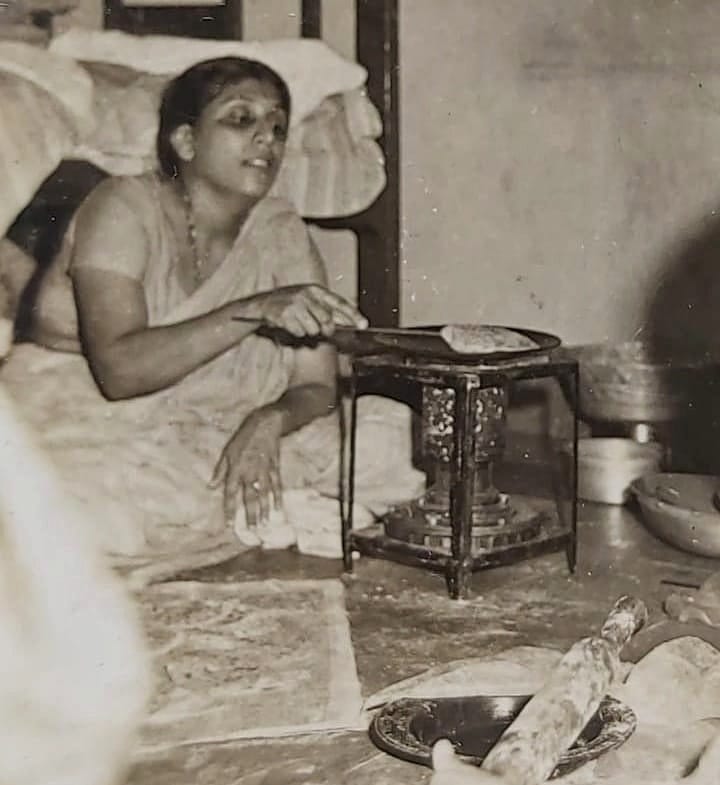My grandmother's kitchen
Most relatives’ lasting image of my grandmother was her carrying pots brimming with fish curry and rice, and laying them down on her gargantuan dining table—built to feed as many people as she could
This essay was originally published in 'Memories on a Plate', by The Alipore Post and Nivaala. Re-published here, because my grandmother will always be an honorary member of my three-person lunch club.
At family dinners and parties, it is a rite of passage for young people to be told stories of their own childhood by elders whose names they simply cannot recall. In my case, one of those oft-repeated stories was about learning to walk in an unusual spot in the house: on the ota, or countertop of my grandmother’s kitchen.
My maternal grandmother — my Amma — looked after me well into my teenage years. I went from taking my first steps on her overcrowded kitchen counter, to sneaking laddus and shev out of tall jars. She’d ply me with snacks as I studied late into the night, and feed me countless dosas after dance class. One evening, when I stepped out to play and did not return home on time, my exasperated mother called Amma — only to find that I’d spent the last hour finishing all the mithai in my grandmother’s fridge.
Over 20 years later, I found myself rummaging through the same ota I’d walked on, and the same cupboards I’d raided. It was the early months of the COVID-19 pandemic, and my grandmother was no longer around.
I sorted through the vessels I could identify — sturdy, dependable kadhais — and marvelled at the more unusual ones that time and changing lifestyles had rendered obsolete — a chakli press, two coconut graters.
In the months after Amma’s passing, I decided to live in her house all alone. It was my first time living away from my parents’ home for an extended period — a seemingly ill-timed experiment, considering how most people were struggling with a dangerous cocktail of cabin fever and isolation from the world. In my mind’s eye, though, it looked exactly like the summers of my childhood: the breeze still made the rose-printed curtains dance, the old Godrej cupboards still housed my favourite adventure and mystery novels.
And yet it was the kitchen of this house that drew me in, compelling me to cook industriously and devour recipes. I moulded dozens of koftas by hand, marinated enough mutton to feed an entire family, and brewed countless cups of tea — all for myself. There was a sense of discovery to each dish, not just because I was cooking it for the first time, but because I’d never cooked in this kitchen before.
Though she’d died only a few months ago, degenerative disease had taken away Amma’s ability to speak and cook at the end of her life. This was a deeply personal loss for her that was palpable to everyone who visited.
Most relatives’ lasting image of my grandmother was her carrying pots brimming with fish curry and rice, and laying them down on her gargantuan dining table — built to accommodate and feed as many people as she could.
We joked that the table was destined to remain in this house because there was no way it could possibly be carried out through the front door.
Those closer to Amma were witness to her at more candid moments, like her hour-long card games, where she would indulge in the occasional glass of beer and gossip.
Conversations with my grandmother became increasingly brief, and ultimately one-sided as she aged. I’d hoped that living in her house would help me overcome the memories of these fragmented moments, where she’d begun to resemble less and less of who she once was. But the grief was only deepened by my realisation that I’d never learnt to cook from her, or even watched her with the intent to learn.
When she was alive, my skills were limited to making rice and under-salted dal; what would she think of my decision to use her fish curry kadhai to make butter chicken? Would she ever take a liking to freshly ground pesto and succulent slices of tomato on toast? Would she scoff at me for using an idli maker instead of little vaatis (bowls), like she always had? These questions further chipped away at my splintered memories.
When I decided to move out and live on my own terms the next year, I carried many of my grandmother’s vessels and ladles with me — the tools that taught and enabled me to nourish and take care of myself at a difficult time. These vessels sit beside champagne flutes and other hand-me-downs from my mother’s home.
My new kitchen was cobbled together with inheritances.
Across suburbs and new homes, they have travelled with me, as I tried to recreate Amma’s version of shevai upma — savoury with a garnish of fresh coconut — and dosas, crisp on the outside and pillowy soft on the inside.
At family get-togethers and birthday lunches, relatives recount the smell and taste of her food, often attempting to devise the ingredients and techniques she may have used. Their investigations lead them nowhere. Consider, for example, the omelettes she whipped up as a last resort, when she ran out of ideas for breakfast — fluffy, golden and redolent with butter. Was it her choice to cook them on a cast iron pan? Did she add a pinch of turmeric to the egg mix?
In ways that are sweet and puzzling, tales of my grandmother’s cooking and generosity have turned into family lore. And I, as the inheritor of her tools and legacy, try to replicate her recipes and find joy in my failures.



